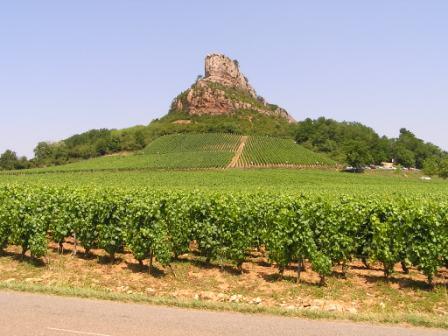| Alsace | Bordeaux | Burgundy | Champagne | Loire Valley | Rhône Valley |

- French call this area Bourgogne and Germans call it Burgund
- Region runs from Auxerre in the north down to Lyon (since the Beaujolais area is included as part of Burgundy)
- Most commonly are red wines made from Pinot Noir grapes or white wines made from Chardonnay grapes
- The red varietal, Gamay, is grown in Beaujolais
- Chablis, Mâcon wines and the Côte d’Or whites are all produced from 100% Chardonnay grapes
- Other whites include Aligoté, which tends to produce cheaper wines which are higher in acidity
- Aligoté from Burgundy is the wine traditionally used for the Kir drink, where it is mixed with black currant liqueur
- Sauvignon Blanc is also produced in limited areas
- Rules generally allow up to 15% of the white grape varieties Chardonnay, Pinot Blanc and Pinot Gris to be blended in, but this is not widely practiced today
- The main levels in the Burgundy classifications, in descending order of quality, are: Grand crus, Premier crus, village appellations, and finally regional appellations
- Burgundy classifications are geographically-focused, unlike Bordeaux, where classifications are producer-driven and awarded to individual chateaux
Burgundy North to South:
Chablis:
- Chablis, a white wine made from Chardonnay grapes, is produced in the area around Auxerre, in the cool north
- Geographically not connected to any other part of Burgundy, located northwest
- Known for producing bone dry whites with high acidity, green fruits, and citrus notes
- The limestone soils give a flinty, minerality
- Usually no detectable oak
- 40 Chablis Premier Cru vineyards
- Only one Chablis Grand Cru AC (7 adjoining vineyards)
Côte d’Or:
- Located over 100 miles southeast of Chablis
- Literally means “golden slope” or “hill of gold”
- split into two parts:
- Côte de Nuits :
- Northern area of Côte d’Or
- Starts just south of Dijon and runs till Corgoloin, a few kilometers south of the town of Nuits-Saint-Georges
- Grows primarily red grapes in this area
- The Côte de Nuits contains 24 out of the 25 red Grand Cru appellations in Burgundy
- Well known villages include, from north to south: Gevrey-Chambertin, Vougeot, Vosne-Romanee, and Nuits-St.Georges.
- Côte de Beaune :
- Southern area of Côte d’Or
- Starts at Ladoix and ends at Dezize-les-Maranges
- All of the region’s white Grand Crus are here (area known mostly for whites)
- Well know villages for white include: Meursault, Aloxe-Corton, Volnay, Puligny-Montrachet, and Chassagne-Montrachet
- Well known villages for red include: Pommard, Beaune, and Santenay
Cote Chalonnaise:
- Continuation of the vineyards of Cote d’ Or
- Unlike Cote d’ Or, there are gaps between the vineyards containing woods and pastures
- AC known for whites: Rully AC and Montagny AC
- AC known for red: Mercurey AC and Givry AC
Mâconnais:
- Largest and most southerly of Burgundy
- Known for producing large quantities of easy-drinking and more affordable white wine (but both red and white grown here)
- Red grapes include: gamay noir, pinot noir, and pinot gris
- White grapes include: pinot blanc and chardonnay
- Examples of designations here: Mâcon: light, fruity (melon and citrus) with no oak and Pouilly-Fuissé: full bodied, tropical fruits (pineapple and melon) and oak (made from 100% Chardonnay)
Beaujolais :
- South of the main area of Burgundy
- famous for fruity red wines made from Gamay
- Beaujolais Nouveau AC: light fruity style released every November (3rd Thursday)
- Beaujolais Villages AC: superior quality comes from granite hills in the north
- Beaujolais Crus found within Beaujolais Villages AC (10 ACs within this region)
- Examples of Beaujolais Crus: Fleurie AC, Brouilly AC, Morgan AC, and Moulin-à-Vent AC

 Masters of Wine
Masters of Wine Wine and Spirits Education Trust
Wine and Spirits Education Trust